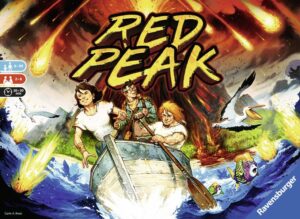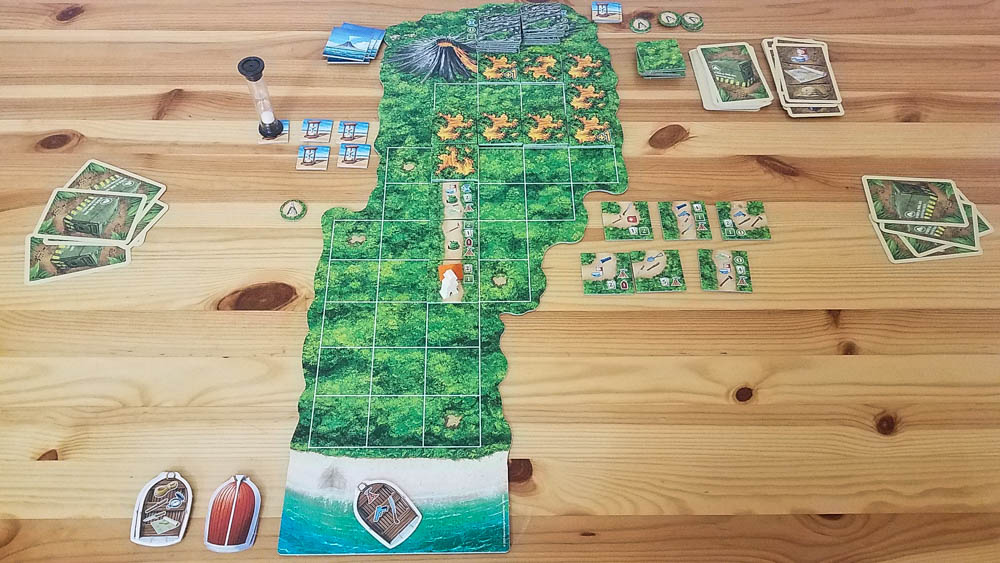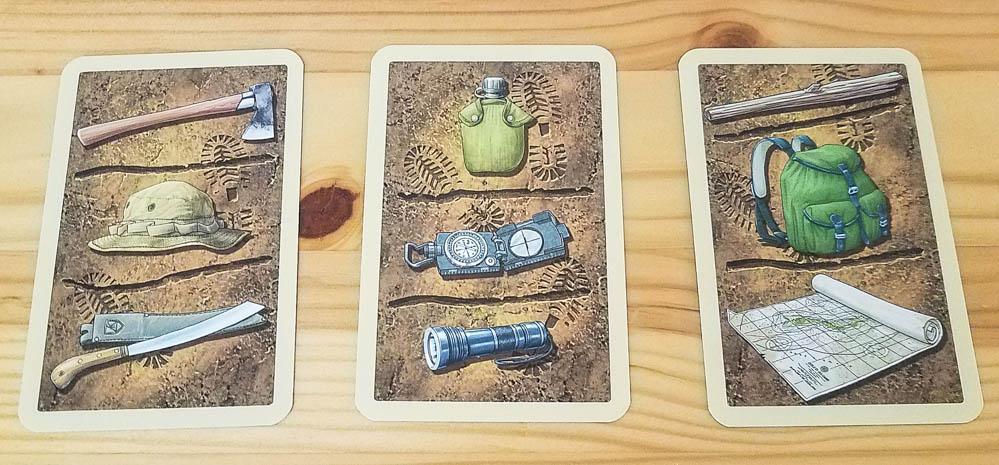Red Peak Review
Year: 2019 | Players: 2-6 | Minutes: 20+ | Ages: 8+
This Red Peak review was made after playing the game four times.
What is Red Peak?
Red Peak is a real-time survival game in which you and your team are attempting to get off of a volcano before its lava reaches you.
This cooperative game was designed by Carlo A. Rossi and is published by Ravensburger.
Rules Overview
In Red Peak, you’ll be working with your teammates to create a path down a volcano in hopes of making it to your escape boat before the lava reaches you. You’ll start out with 12 tool cards split between the players (face-down at first) and seven path tiles to choose from for the first round.
The timed Daytime phase is where most of the action happens. You begin the phase by flipping the 90-second sand timer and picking up your tool cards. You can talk about the tool cards that you have, but you can’t show them to your teammates. What you’re trying to do is figure out which path tiles you can place on the board; you do this by matching the tool symbols on your cards to the symbols on the tiles. The first part of this phase is putting the path tiles on the board and the second is discarding the required tool cards to move the Adventurer pawn along the new path.
After you’re done moving the Adventurer, everyone puts their tool cards face-down and you won’t pick them up again until the start of the next Daytime phase. You’ll then check to see if there is any sand left in the sand timer. If there is, nothing happens. If there isn’t, you’ll move the sand timer to the next time tile (you start with three). If there aren’t any time tiles remaining, you’ll add a new one to the timeline and a lava tile is drawn.
During the Evening phase you’ll move the Tent pawn along the path until it reaches the Adventurer pawn. Each tile the tent moves across gives your team rewards (reward icons are on the path tiles), such as more tool cards, a new escape boat, or more path tiles to choose from. This is also the main way that the volcano erupts and lava tiles get added to the board. At the end of the Evening phase, you can optionally get more tool cards, path tiles, and other resources if you’re willing to add more lava tiles to the board. Then you’ll plan for the next Daytime phase by looking at the available path tiles and trying to remember which tool cards you have.
You’ll beat Red Peak if the adventurer and the tent make it to the boat. You’ll lose if the lava ever reaches the tent.
There are also optional bonus tiles included with the game that you can place on certain spots on the board, making the game slightly easier. To make the game a bit more difficult, you can play on the reverse side of the board and use the quest cards, which force you to hit specific spots in the jungle on your way to the boat.
Check out our Top 10 Real-Time Games!
Pros and Cons
Pros
- My favorite thing about Red Peak is that everyone is involved throughout the game and that it requires good communication. If you don’t work well together to find the right combinations of tools, you’ll probably lose.
- Most games go right down to the wire. A lot of the path tiles have eruption icons on them, so the lava is usually going to be pretty close to you regardless of how quickly you move through the jungle.
- It’s great that you have a chance to get some extra resources at the end of each round. It allows you to counter some of the tile and card randomness.
- The game works well at all player counts. The only thing that changes is the number of tool cards each player gets.
- Speaking of rules, just about anyone can learn how to play Red Peak in a couple of minutes. This is a game even younger kids should be able to get into… and maybe even play on their own.
- You’re not going to run into the dreaded quarterbacking issue while playing this one. The most important information is hidden, so it’s almost impossible for one player to take over.
- I like all of the art in Red Peak. The volcano and jungle on the board look fantastic and the tools on the cards really pop. Vincent Dutrait and Nora Nowatzyk did a great job.
Cons
- It didn’t take long for the game to start feeling samey for my group. The randomness of the tiles and cards does change the puzzle a little bit, but the real challenge of this game is figuring out how to quickly communicate what’s in your hands. Once you get that down, the tension level drops and the game isn’t as interesting. Midway through our third game we had a system down and the only way we were going to lose was if we got very unlucky with the path tiles and cards.
- The sand timer doesn’t put as much pressure on players as I was expecting it to. First of all, it’s really hard to run out of time tiles so you’re usually not worried about taking more than 90 seconds. And secondly, if you are worried about the timer, you can just place one path tile per turn; the only downside of doing that is the game takes a bit longer.
- Some of the tool symbols on the cards don’t perfectly match the symbols on the path tiles. You do get used to them, but during my group’s first couple of games we had some trouble quickly seeing if we had the tools we needed.
Final Thoughts
I probably won’t be playing Red Peak with my main gaming group again since we’ve kind of figured it out after four games. That’s not really putting the game down, though, since I’m pretty sure it was designed for families to play.
I think Red Peak would be a good game to check out if you have children in the 7-12 age range and they’re interested in this survival theme. It’s a unique cooperative game that’s very easy to learn, looks great on the table, and requires a good amount of teamwork. It’s just not a game that I’ll be keeping.
Red Peak Links
BGG | Noble Knight
Thanks for taking the time to read our Red Peak review!
To stay updated on all things cooperative board games, follow us on Twitter, Facebook, or via RSS.




